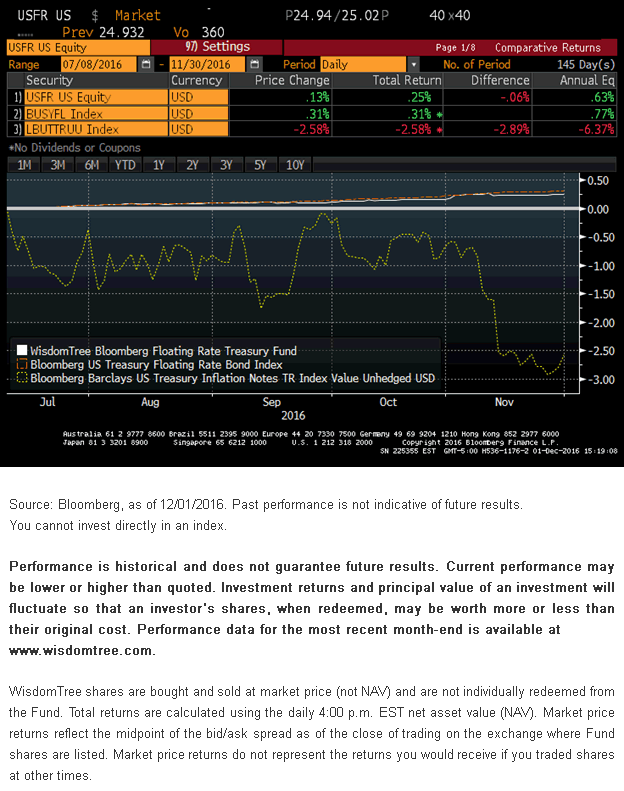Fixed Income: Staying A "float"


In what will no doubt be viewed as a gross understatement, the dynamics have certainly changed within the fixed income universe following the U.S. presidential election. However, how investors go about adjusting their portfolio to these changing conditions can certainly vary.
The surge in U.S. Treasury (UST) yields since election day has been of historical proportions in terms of the timing and magnitude of such a move. Yet, taking it one step further, the UST yield has now risen more than 100 basis points (bps) since hitting its all-time low on July 8 of this year. As a result, interest rate risk has been brought front and center into the fixed income investment discussion.

One strategy investors have employed is to reallocate their holdings to inflation-protected vehicles. Indeed, the argument for such an approach is that higher interest rates are a function of heightened inflation, and by that reasoning, that fixed income investors can help insulate their portfolios from rising rates by placing funds into these inflation-protected vehicles. In fact, looking at flows into U.S. inflation-protected exchange traded funds (ETFs) over the last quarter highlights how this strategy has been utilized. To provide some perspective, as of this writing, U.S. inflation-protected ETFs have taken in roughly $3.6 billion quarter-to-date. It is interesting to note that $2.5 billion, or more than 70% of these inflows, have occurred in the month of November alone, no doubt a reflection of the “rate anxiety” that has occurred post-election.
So, how have U.S. Treasury Inflation-Protected Securities (TIPS) held up since early July? After examining the yield performance, investors may be a bit surprised by the results. To illustrate, the five-year maturity has witnessed a nearly 50-bp back-up in yield while the 10-year TIPS registered an almost 60-bp increase in yield during this time frame. In other words, real yields actually rose as well.
This begs the question: Is this the optimal strategy to shield one’s fixed income portfolio from the potential for rising rates? In our opinion, we believe there is an alternative approach investors should explore: floating rate products. Investors looking to mitigate potential interest rate exposure may wish to examine the benefit of floating rate Treasury securities (FRNs). The U.S. Treasury began issuing two-year FRNs in January 2014. The yield is reset weekly based on a reference rate that is determined at the weekly three-month Treasury bill auction. As a result, they have the potential to reset interest rates more frequently as short-term yields drift higher. The WisdomTree Bloomberg Floating Rate Treasury Fund (USFR), which seeks to track the price and yield performance of the Bloomberg U.S. Treasury Floating Rate Bond Index, offers investors a vehicle to follow this type of strategy.
Conclusion
For the first time this year, it appears as if global investors have finally agreed upon one thing: the Fed will lift the target range on Fed Funds by a quarter point at next week’s FOMC meeting. Given the relatively high odds of a rate hike and the potential for additional increases in the Fed Funds Rate in 2017, some “Fed protection” seems warranted. Against this backdrop, due to the weekly reset feature of Treasury FRNs, we feel that by utilizing a floating rate product such as USFR, investors may be better able to insulate their bond portfolios than with a more traditional fixed income investment.


